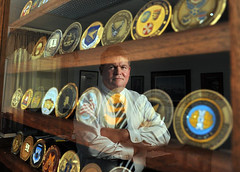
PREV ARTICLE
NEXT ARTICLE
FULL ISSUE
PREV FULL ISSUE
CHALLENGE COINS BECOME COPYCAT FAD AMONG BUREAUCRATS, POLITICIANS
On the heels of last week's item about former Mint Director Ed Moy's "Director's Coin for Excellence" comes an article this week in The Washington Post noting how so many non-military government units have picked up on the Challenge Coin bandwagon. -Editor
To an outsider, the coin might have seemed like little more than a curious, poker chip-size trinket, designed with the emblem of her Illinois National Guard unit. To Duckworth, now an assistant secretary of veterans affairs, it was sacred: "That's my identity." "Challenge coins," as they are known, have become an important part of the ethos of the armed forces, where the story of service members' careers - deployments, promotions, awards - is told by the ribbons and patches on their uniforms. Traditionally, commanders hand out the coins to troops for exemplary service and morale boosting. That's how Duckworth got hers. That's why it meant so much. But in recent years, many outside the military have adopted the tradition, turning a sacrosanct ritual, some say, into a form of military chic that is now part of the Washington power game. The coin craze extends into almost every nook of the federal government. The secretaries of education, transportation and agriculture have coins. So does the EPA administrator, and even the Department of Agriculture's Office of Information Technology. The coins have gone global - the Australian ambassador has one. And corporate: Boeing has a coin. So does Starbucks. This coin creep is to some in the military an off-putting act of plagiarism that sullies the tradition. To others, it's a flattering statement of solidarity with those who serve. "I don't see it as an offense," said Navy Capt. John Kirby, spokesman for Adm. Mike Mullen, the Joint Chiefs of Staff chairman. "I look at it as them wanting to associate with the sacrifice that the military is making." But others fear that the coins have become more about vanity - both the giver's and the receiver's - than about service and sacrifice. "They've become like an autograph. It's a thing to say, 'I met this person,'" said Todd Bowers, who served two tours in Iraq and one in Afghanistan with the Marine Corps and is an official at Iraq and Afghanistan Veterans of America (yes, the nonprofit group has a coin). "Now they're business cards." It is unclear how the coin tradition began, but the earliest one Jesse Medford, founder of the Challenge Coin Association, has ever seen was a 17th Infantry Division coin from the early 1950s. Special Forces units used them in the 1980s and the tradition slowly spread through the armed forces. "It's been the last 10 years where it's spread like wildfire, definitely since the wars have been going on," he said. In the past couple of years, the popularity of the coins has become "so vast that it's almost better to say who doesn't have a coin," said Adam Mulholland, owner of U.S. Challenge Coins, a Georgia manufacturer. As the craze has taken off, the coins have gotten more elaborate - and expensive. McIntyre spent $6 a coin on his second batch, $7.50 on the next. The last batch cost $10 apiece, so he tried to be more discerning about whom he gave them to. But it had reached the point where it seemed everyone was handing out a coin. "We're one step away from your neighbor giving you a coin for mowing the lawn," he joked. The costs can add up. The office of the chairman of the Joint Chiefs of Staff spent $187,500 on 37,500 coins last year, according to a spokesman.
To read the complete article, see:
Military's prized 'challenge coins' become copycat fad among agencies, politicians, companies
(www.washingtonpost.com/wp-dyn/content
To read the earlier E-Sylum, see:
MOY'S "DIRECTOR'S COIN FOR EXCELLENCE"
(www.coinbooks.org/esylum_v14n08a14.html)
The Numismatic Bibliomania Society is a non-profit organization promoting numismatic literature. See our web site at coinbooks.org. To submit items for publication in The E-Sylum, write to the Editor at this address: whomren@gmail.com To subscribe go to: https://my.binhost.com/lists/listinfo/esylum All Rights Reserved. NBS Home Page Contact the NBS webmaster 
|
